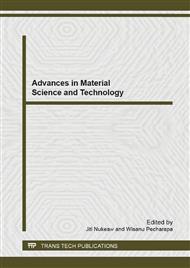[1]
L. Lu, D. Shen, J. Zhang, J. Song, L. Li, Evolution of micro-arc oxidation behaviors of the hot-dipping aluminum, Applied Surface Science. 257 (2011) 4144–4150.
DOI: 10.1016/j.apsusc.2010.11.187
Google Scholar
[2]
P. Haoping, S. Xuping, L. Zhi, W. Jianhua, W. Changjun, T. Hao, L. Xiaofeng, Synergistic effect of Cu and Si on hot-dipping galvalume coating, Surface & Coatings Technology. 206 (2012) 4329–4334.
DOI: 10.1016/j.surfcoat.2012.01.048
Google Scholar
[3]
T. Siwach, O. Masahiro, Electroless nickel plating on polypropylene via hydrophilic modification and supercritical carbon dioxide Pd-complex infusion, J. of Supercritical Fluids. 69 (2012) 117– 123.
DOI: 10.1016/j.supflu.2012.06.002
Google Scholar
[4]
K. B. Vijaya, T. Harjyoti, U. Ramgopal, K P. Mihir, Effect of process parameters on electroless plating and nickel-ceramic composite membrane characteristics, Desalination. 268 (2011) 195–203.
DOI: 10.1016/j.desal.2010.10.025
Google Scholar
[5]
A. D. George, Modern Electroplating, John Wiley & Sons, Inc. (2010) 79-80.
Google Scholar
[6]
N. V. Mandich, H. Geduld, Understanding and Troubleshooting Decorative Nickel Electroplating Systems-Part I: Introduction and Brightness Problems, Metal finishing. (2002) 83-91.
DOI: 10.1016/s0026-0576(02)80160-x
Google Scholar
[7]
S. Fumitaka, K. Keisuke, N. Yuzuru, K. Koichi, S. Yuishi, Nickel Electroplating Bath Using Malic Acid as a Substitute Agent for Boric Acid, Metal finishing. (2007) 34-40.
DOI: 10.1016/s0026-0576(07)80545-9
Google Scholar
[8]
D. Tadashi, M. Kazunari, Bright Nickel Plating from Nickel Citrate Electroplating Baths, Tokyo Metropolitan Industrial Technology Research Institute. (2004).
Google Scholar
[9]
L.S. Donald, Electroplating Nickel/Chromium for the Automotive Industry, Metal finishing. (1997).
Google Scholar
[10]
W. Sheng-Chang, J. W. Wen-Cheng, Kinetics of electroplating process of nano-sized ceramic particle/Ni composite, Materials Chemistry and Physics. 78 (2003) 574–580.
DOI: 10.1016/s0254-0584(01)00564-8
Google Scholar
[11]
Z. Abdel-Hamid, Materials Science Communication Improving the throwing power of nickel electroplating baths, Materials Chemistry and Physics. 53 (1998) 235-238.
DOI: 10.1016/s0254-0584(97)02070-1
Google Scholar
[12]
W. Chao, Z. Yunbo, R. Weili, L. Zuosheng, R. Zhongming, J. Jing, J. Airong, Effects of parallel magnetic field on electrocodeposition behavior of Ni/nanoparticle composite electroplating, Applied Surface Science. 254 (2008) 5649–5654.
DOI: 10.1016/j.apsusc.2008.03.072
Google Scholar
[13]
W. Bensalah1, M. Feki, M. Wery, H.F. Ayedi, Thick and Dense Anodic Oxide Layers Formed on Aluminum in Sulphuric Acid Bath, J. Mater. Sci. Technol. 26(2) (2010) 113-118.
DOI: 10.1016/s1005-0302(10)60018-7
Google Scholar
[14]
R. Zhang , K. Jiang, G. Ding, Surface morphology control on porous anodic alumina in phosphoric acid, Thin Solid Films. 518 (2010) 3797–3800.
DOI: 10.1016/j.tsf.2010.01.004
Google Scholar
[15]
N. M. Yakovleva, L. Anicai, A. N. Yakovlev, L. Dima, E. Ya. Khanina, E. A. Chupakhina, Structure and Properties of Anodic Aluminum Oxide Films Produced in HNO3 Solutions, Inorganic Materials. 39 (2003) 50–56.
DOI: 10.1023/a:1021839219347
Google Scholar
[16]
J.Zhang, J. E. Kielbasa, D. L. Carroll, Controllable fabrication of porous alumina templates for nanostructures synthesis, Materials Chemistry and Physics. 122 (2010) 295–300.
DOI: 10.1016/j.matchemphys.2010.02.023
Google Scholar
[17]
C. Tso-Fu Mark, S. Masato, Function and mechanism of supercritical carbon dioxide emulsified electrolyte in nickel electroplating reaction, Surface & Coatings Technology. 205 (2011) 3890–3899.
DOI: 10.1016/j.surfcoat.2011.02.004
Google Scholar


